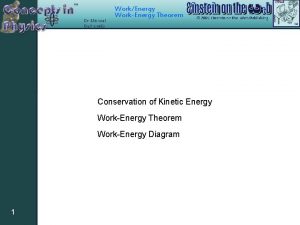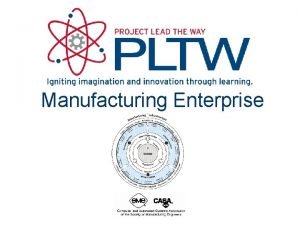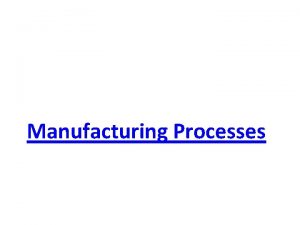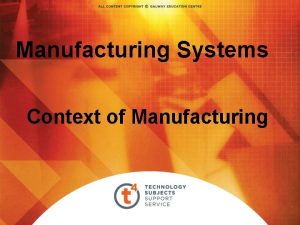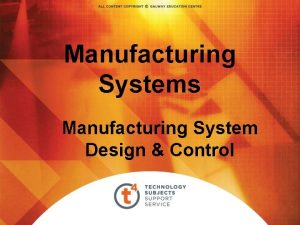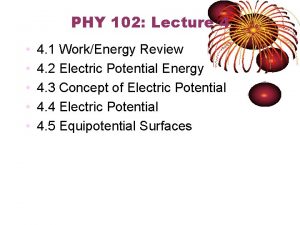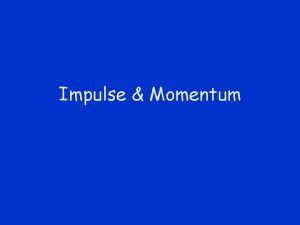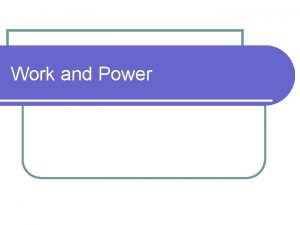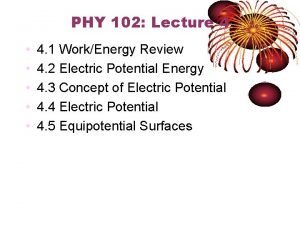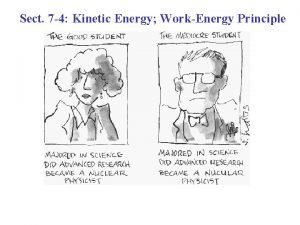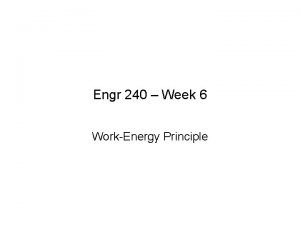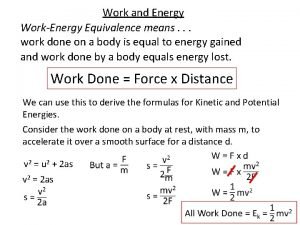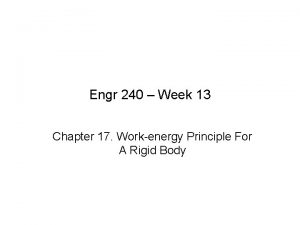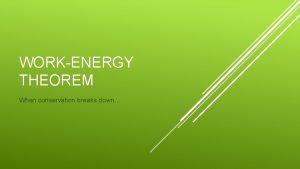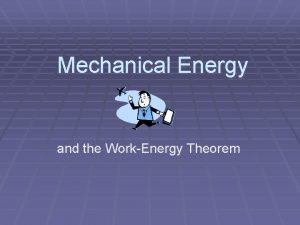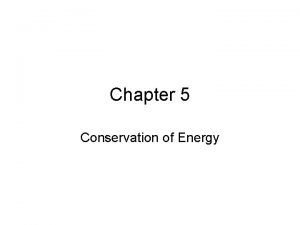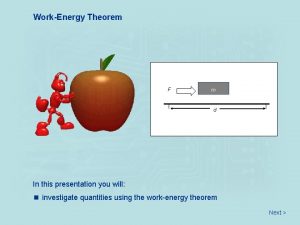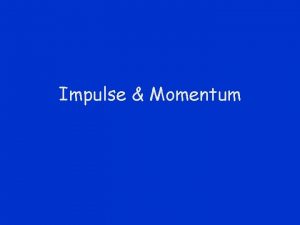The Minimum WorkEnergy for Manufacturing P M V



























- Slides: 27

The Minimum Work/Energy for Manufacturing P M V Subbarao Professor Mechanical Engineering Department The Most Important Bench Mark…

Types of Work Transfers in Manufacturing • Moving Boundary work (displacement work) – Extrusion – Metal cutting – Forging • Shaft work • Electrical work • Steam/gas work

Study of Pressure-Volume Diagrams. • The rapid rise in pressure during initial ram travel is due to the initial compression of the billet to fill the extrusion container. • For direct extrusion, the metal begins to flow through the die at the maximum pressure. • This pressure is called as the breakthrough pressure. • As the billet extrudes through the die the pressure required to maintain flow progressively decreases with decreasing length of the billet in the container. • At the end of the stroke, the pressure rises up rapidly and it is usual to stop the ram travel so as to leave a small discard in the container.

Innovative Design to modify Pressure volume Diagram

Thermodynamic definition of Plastic Deformation Work Themodynamically simple displacement work : • A bar of initial length l 0 is subjected to a force F acting upon an area A 0 and an extrusion dl occurs, the work consumed is: Work consumed by unit volume of extruded material is:

Most Generic Extrusion Work • Stress and strain are tensors. • The generalized work consumed can be represented as:

Effective Strain & Stress • Effective stress and strain are defined for each extrusion case as: • Von Mises proposed an expression for effective stress as: • i are called as principle stresses and obtained as roots of a cubic equation :

Effective Strain & Stress • The simplified form of specific work equation is

Specific work done during Extrusion of Axisymmetric incompressible solids

Common Models for Extrude Materials • Ductile aluminum alloys are most preffered material for extrusion. • For infinitesimally slow extrusion.

Impact of Thermodynamic Analysis of Extrusion

Displacement Work during Metal Cutting Themodynamically simple displacement work : The total cutting work consumed in machining can be defined as the sum of shear work and friction work. Also defined as primary shear work and secondary shear work.

Simple model for Primary Shear Work Primary shear work is estimated as: The layer to be removed of thickness t 1 transforms into the chip of thickness t 2 as a result of shear deformation that takes place along a certain unique plane AO. This plane is inclined to the cutting plane at an angle ϕ. This is called as single shear plane model. This plane moves with at velocity Vs parallel to Fs relative to Tool

Comprehensive model for Primary Shear Work • Plastic zone LOM is limited by shear line OL, along which the first plastic deformation in shear occurs. • Shear line OM along which the last shear deformation occurs.

Visualization of Cutting as A Work • Line LM is “the surface of the cut”. • The plastic zone LOM includes “a family of shear lines along which growing shear deformation are formed successively. ” • This shape of the deformation (plastic) zone is based on the multiple experimental studies and this is more than a very serious statement. • Based on this model the specific work consumption is:

Model for Specific Work during Cutting • Based on previous model the specific work consumption is:

Effective Plastic Zone Stress during Metal Cutting

Generation of Shaft Work Energy transmission with a rotating shaft is very common in engineering practice. A force F acting through a moment arm rs, p generates a torque T of

Flowing Fluid Work

Flowing Fluid Work in a Polytropic Process


The Faraday’s Work : An Amazing form of Work Transfer • Consider a conducting rod PQ moving at a steady speed V perpendicular to a field with a flux density B. • An electron (negative charge e) in the rod will experience a force (= Be. V) that will push it towards the end P.

Description of Work done by A Conductor • The same is true for other electrons in the rod, so the end P will become negatively charged, leaving Q with a positive charge. • As a result, an electric field E builds up until the force on electrons in the rod (unit length) due to this electric field (= Ee) balances the force due to the magnetic field Force per unit charge on Rod of unit length:

Identification of A Novel Force For a rod of length L, define the EMF as : What happens when the EMF drives a current in an external circuit? To do this, imagine that the rod moves along a pair of parallel conductors that are connected to an external circuit

Electrical Loading of Conductor The EMF will now cause a current to flow in the external resistor R. This means that a similar current flows through the rod itself giving a magnetic force, BIL to the left.

Quantification of the Faraday’s Work L is now the separation of the two conductors along which the rod PQ moves. An equal and opposite force (to the right) is needed to keep PQ moving at a steady speed. In a time dt, the rod moves a distance dx = Vdt Infinitesimal Work done on the rod

The Pairs of Work Transfers Energy dissipated in R = power x time = EMF× I× t Giving : B × I × L ×V × t = EMF × I × t or, as before, EMF = B × V × L http: //tap. iop. org/fields/electromagnetism/414/page_469 48. html ?
 Local minimum
Local minimum Manufacturing cost vs non manufacturing cost
Manufacturing cost vs non manufacturing cost Additive manufacturing steps
Additive manufacturing steps Job costing and process costing
Job costing and process costing Cost concept and classification
Cost concept and classification Manufacturing cost vs non manufacturing cost
Manufacturing cost vs non manufacturing cost Presentera för publik crossboss
Presentera för publik crossboss Myndigheten för delaktighet
Myndigheten för delaktighet Att skriva debattartikel
Att skriva debattartikel Var 1721 för stormaktssverige
Var 1721 för stormaktssverige Tobinskatten för och nackdelar
Tobinskatten för och nackdelar Nationell inriktning för artificiell intelligens
Nationell inriktning för artificiell intelligens Referat mall
Referat mall Sten karttecken
Sten karttecken Mjälthilus
Mjälthilus Byggprocessen steg för steg
Byggprocessen steg för steg Rådet för byggkompetens
Rådet för byggkompetens Lufttryck formel
Lufttryck formel Särskild löneskatt för pensionskostnader
Särskild löneskatt för pensionskostnader Vad är densitet
Vad är densitet Elektronik för barn
Elektronik för barn Borra hål för knoppar
Borra hål för knoppar Tack för att ni har lyssnat
Tack för att ni har lyssnat Smärtskolan kunskap för livet
Smärtskolan kunskap för livet Bris för vuxna
Bris för vuxna Vad är ett minoritetsspråk
Vad är ett minoritetsspråk Trög för kemist
Trög för kemist Magnetsjukhus
Magnetsjukhus




























